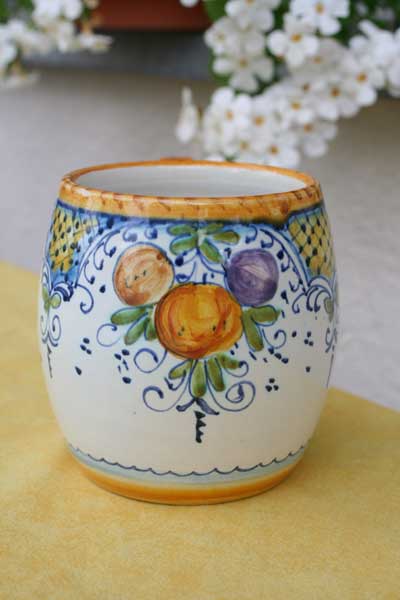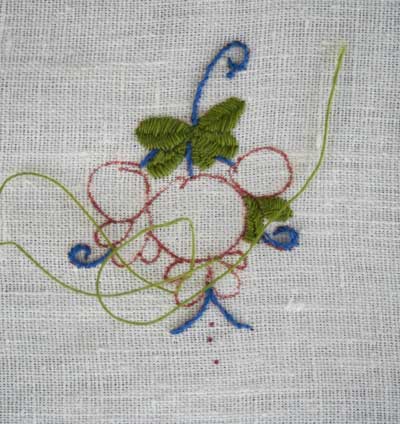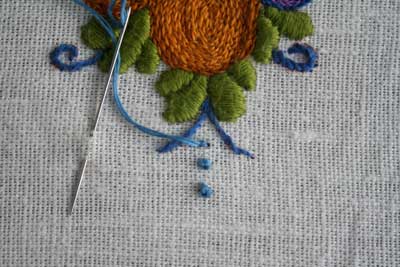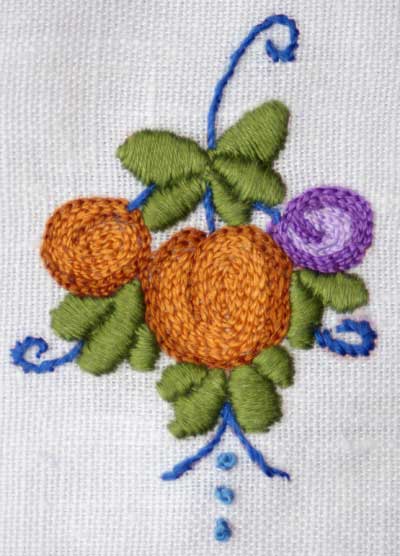Here’s the third post on Kathy’s “Spring in Italy” Sampler, focusing on embroidering a motif using cotton floche, which is an all-time favorite thread of mine! (Well, it, and a how many other favorite threads? We better not count!) Floche is a beautiful cotton thread. It’s a non-strandable mercerized cotton with a wonderful sheen, and it’s very soft and fine. If you’d like to read more about it, you can check out this comparison of floche with Danish flower thread (a matte thread) or this comparison of floche with other cottons. You can also check out this delectable collection of the range of cotton floche, which I love looking at, but haven’t touched yet!
Kathy Andrews is guest writing this series of articles for Needle ‘n Thread on using Italian pottery as inspiration for an embroidery project. For more information on her project, her first article covers the design process and her second article takes a look at working a motif in wool.

The second motif of the Spring in Italy Sampler is a design of leaves and three plums. The stems are worked in blue rather than a realistic green to balance the colors. This is how it is painted on the pottery and I really like the color choices in this design, including the purple plum – more about that later.
Firstly, I began by working the stems first with dark blue thread in stem stitch. Then I moved on to the leaves, working all the leaves in fishbone stitch. In almost every embroidery pattern I’ve ever used the order of stitching has been stems first, leaves second and then the rest.
This is the first time I’ve used floche a broder so I had to get used to stitching with it. It is a more unforgiving thread than Appleton wool (fuzzy = forgiving). I thought I was being very precise about placing the stitches as I worked the leaves. However, I had trouble making the stitches small enough for the tiny leaves. The largest leaf is only 1.3 cm or 1/2 inch long and 0.6 cm or 1/4 inch wide. The smallest leaf is 0.6 cm or 1/2 inch long and 0.4 cm or a little more than 1/4 inch wide.

Floche a broder is a non-divisible thread and the thickness of the thread prevented me from making stitches fine enough. At least that’s my rationalization. It could be my less-than-perfect technique! However, I foolishly persevered until I’d stitched all the leaves. I was hoping it would look better as I went along. Ha! Then I took a photo, enlarged and looked at the photo and decided I would be embarrassed to show anyone such messy work. So, using my trusty tweezers, I picked it out. (That’s beginning to be a theme with this project – stitch, pick out, stitch…)
It now seemed that the best stitch to use for the leaves would be satin stitch. To be successful when working satin stitch, you should always outline the shape first with split stitch and then pad the shape. For great instruction on how to work a beautiful satin stitch, go to Mary’s post, Some Notes on Satin Stitch. (You can also check out the how-to video on padded satin stitch, if you want!) The leaves look much better and I’m really proud of how well they turned out. I love how puffy they are and how smooooooth!

When it came time to put the French knots in at the bottom of the design, I had a lot of trouble getting the knots to stay on the front side of the linen. They kept getting pulled through. This linen is nice; it has a good hand, but isn’t woven really tightly. My solution was to make a tiny straight stitch and then work the French knot on top of the straight stitch. It worked beautifully!
This is where my color scheme had to change… blue would have to make room for purple…

The plums on the Italian pottery are gold and purple. Purple wasn’t a color I originally decided to use but a blue plum doesn’t look ‘plumy’ – it just looks silly, like an overgrown blueberry. Fortunately I have purple cotton threads so adapting the color scheme wasn’t difficult. I worked all three plums in chain stitch, stitching from the outside to the center in a spiral so the line of the stitch mimicked the curve of the plum.
This project is really fun and I am learning a lot about designing needlework.
Next time I’ll have finished the design stitched in the first of four silk threads. It will be my first experience stitching with Pearsall’s Silk from Wales and I am really excited to try it!
Ya gotta love floche! The plums turned out gorgeous! I love this whole project so far! But if you’ve been reading along on Needle ‘n Thread for a while, you know I’m particularly and inordinately fond of silk, so I’m really looking forward to the Kathy’s installment on using Pearsalls! I hope you are, too! Thanks, Kathy!







Gday Mary and Kathy,
Yep, the satin stitch looks good on the leaves.
It’s funny how the leaves are puffy and the ’rounded’ fruit is flat but it looks just right. Must be because of the wonderful way you’ve placed the shades of colour and the direction of the chain stitches to give them dimention.
I really love those plums. They give me “funny, familiar, forgotten, feelings” of growing up on my parents orchard. We grew plums, apples, cherries, pears and nectarines (table grapes in earlier years).
Thanks for this beaut post. Cheers, Kath.
I am most familiar with using floche for white embroidery (Madiera, heirloom, monograms) and find it a remarkable thread for doing padded satin stitch. A needlework teacher once explained that it has its own “loft” quality and because it is not a tightly twisted thread, the little fibers sort of spread and “felt” in the padded satin stitch format. For this reason I think it is not the best thread for small, precise stitches which is probably why you were much happier with your satin stitch leaves (which are lovely!). I look forward to your silk article! Thanks.
What type of fabric is Kathy stitching on? I’ve just begun working with floche a little more recently. Thanks very much to both of you for these articles.
Hi Kathy,
Love your idea for making French Knots stay put. Also, using chain stitch in a spiral is such an effective idea.
The finished design looks fantastic.
By the way, thank you for sharing these motif designs.
I must say that I may use one of them for another sampler effect …… repeating just one specific motif but using different types of stitches for each one and keeping the same thread type. As a beginner to free style embroidery, trying to decide on what stitch looks best is what I find so daunting.
Elaine
Cheshunt, Hertfordshire, UK
Interesting idea with the French knots, Kathy. Did you use the same holes for the knot as for the small straight stitch, or did you stitch through the straight stitch after wrapping the thread around the needle? Some days the knots I make are lovely, most days – you’d think I was using a piece of lumber to make them, not a needle! I’m never sure if it’s me, the thread, or the fabric.